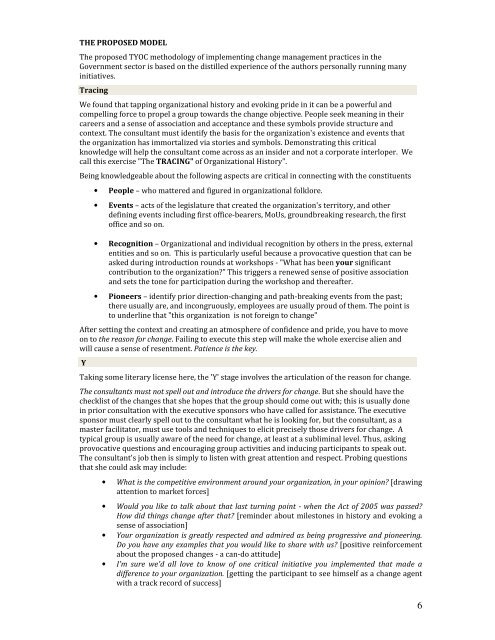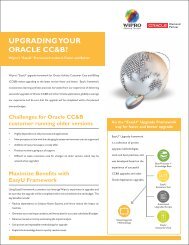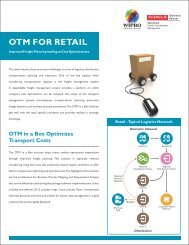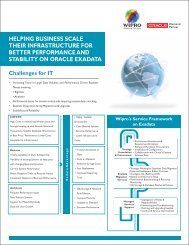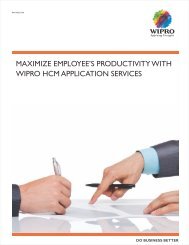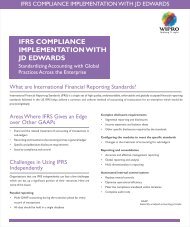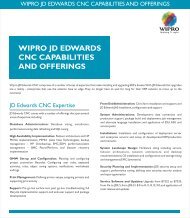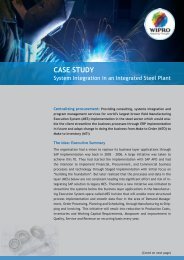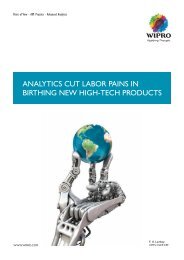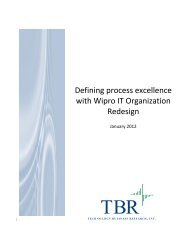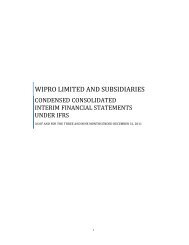Applying Change Management Practices in Government - Wipro
Applying Change Management Practices in Government - Wipro
Applying Change Management Practices in Government - Wipro
Create successful ePaper yourself
Turn your PDF publications into a flip-book with our unique Google optimized e-Paper software.
THE PROPOSED MODEL<br />
The proposed TYOC methodology of implement<strong>in</strong>g change management practices <strong>in</strong> the<br />
<strong>Government</strong> sector is based on the distilled experience of the authors personally runn<strong>in</strong>g many<br />
<strong>in</strong>itiatives.<br />
Trac<strong>in</strong>g<br />
We found that tapp<strong>in</strong>g organizational history and evok<strong>in</strong>g pride <strong>in</strong> it can be a powerful and<br />
compell<strong>in</strong>g force to propel a group towards the change objective. People seek mean<strong>in</strong>g <strong>in</strong> their<br />
careers and a sense of association and acceptance and these symbols provide structure and<br />
context. The consultant must identify the basis for the organization's existence and events that<br />
the organization has immortalized via stories and symbols. Demonstrat<strong>in</strong>g this critical<br />
knowledge will help the consultant come across as an <strong>in</strong>sider and not a corporate <strong>in</strong>terloper. We<br />
call this exercise "The TRACING" of Organizational History".<br />
Be<strong>in</strong>g knowledgeable about the follow<strong>in</strong>g aspects are critical <strong>in</strong> connect<strong>in</strong>g with the constituents<br />
• People – who mattered and figured <strong>in</strong> organizational folklore.<br />
• Events – acts of the legislature that created the organization's territory, and other<br />
def<strong>in</strong><strong>in</strong>g events <strong>in</strong>clud<strong>in</strong>g first office-bearers, MoUs, groundbreak<strong>in</strong>g research, the first<br />
office and so on.<br />
• Recognition – Organizational and <strong>in</strong>dividual recognition by others <strong>in</strong> the press, external<br />
entities and so on. This is particularly useful because a provocative question that can be<br />
asked dur<strong>in</strong>g <strong>in</strong>troduction rounds at workshops - "What has been your significant<br />
contribution to the organization?” This triggers a renewed sense of positive association<br />
and sets the tone for participation dur<strong>in</strong>g the workshop and thereafter.<br />
• Pioneers – identify prior direction-chang<strong>in</strong>g and path-break<strong>in</strong>g events from the past;<br />
there usually are, and <strong>in</strong>congruously, employees are usually proud of them. The po<strong>in</strong>t is<br />
to underl<strong>in</strong>e that "this organization is not foreign to change"<br />
After sett<strong>in</strong>g the context and creat<strong>in</strong>g an atmosphere of confidence and pride, you have to move<br />
on to the reason for change. Fail<strong>in</strong>g to execute this step will make the whole exercise alien and<br />
will cause a sense of resentment. Patience is the key.<br />
Y<br />
Tak<strong>in</strong>g some literary license here, the 'Y' stage <strong>in</strong>volves the articulation of the reason for change.<br />
The consultants must not spell out and <strong>in</strong>troduce the drivers for change. But she should have the<br />
checklist of the changes that she hopes that the group should come out with; this is usually done<br />
<strong>in</strong> prior consultation with the executive sponsors who have called for assistance. The executive<br />
sponsor must clearly spell out to the consultant what he is look<strong>in</strong>g for, but the consultant, as a<br />
master facilitator, must use tools and techniques to elicit precisely those drivers for change. A<br />
typical group is usually aware of the need for change, at least at a sublim<strong>in</strong>al level. Thus, ask<strong>in</strong>g<br />
provocative questions and encourag<strong>in</strong>g group activities and <strong>in</strong>duc<strong>in</strong>g participants to speak out.<br />
The consultant's job then is simply to listen with great attention and respect. Prob<strong>in</strong>g questions<br />
that she could ask may <strong>in</strong>clude:<br />
• What is the competitive environment around your organization, <strong>in</strong> your op<strong>in</strong>ion? [draw<strong>in</strong>g<br />
attention to market forces]<br />
• Would you like to talk about that last turn<strong>in</strong>g po<strong>in</strong>t - when the Act of 2005 was passed?<br />
How did th<strong>in</strong>gs change after that? [rem<strong>in</strong>der about milestones <strong>in</strong> history and evok<strong>in</strong>g a<br />
sense of association]<br />
• Your organization is greatly respected and admired as be<strong>in</strong>g progressive and pioneer<strong>in</strong>g.<br />
Do you have any examples that you would like to share with us? [positive re<strong>in</strong>forcement<br />
about the proposed changes - a can-do attitude]<br />
• I'm sure we'd all love to know of one critical <strong>in</strong>itiative you implemented that made a<br />
difference to your organization. [gett<strong>in</strong>g the participant to see himself as a change agent<br />
with a track record of success]<br />
6


